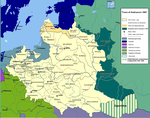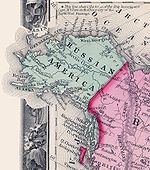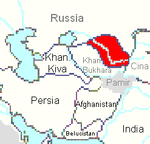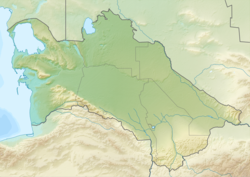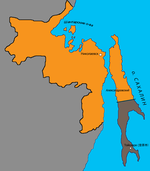Territorial evolution of Russia
This article is missing information about Russia's total maximum expansion. (December 2023) |

The borders of Russia changed through military conquests and by ideological and political unions from the 16th century.
Tsarist Russia
The formal end to Tatar rule over Russia was the defeat of the Tatars at the Great Stand on the Ugra River in 1480. Ivan III (r. 1462–1505) and Vasili III (r. 1505–1533) had consolidated the centralized Russian state following the annexations of the Novgorod Republic in 1478, Tver in 1485, the Pskov Republic in 1510, Volokolamsk in 1513, Ryazan in 1521, and Novgorod-Seversk in 1522.[1]
After a period of political instability between 1598 and 1613, which became known as the
This continued for centuries; by the end of the 19th century, the
that lasted only a month.Expansion into Asia

The first stage from 1582 to 1650 resulted in North-East expansion from the Urals to the Pacific. Geographical expeditions mapped much of Siberia. The second stage from 1785 to 1830 looked South to the areas between the Black Sea and the Caspian Sea. The key areas were Armenia and Georgia, with some better penetration of the Ottoman Empire, and Persia. By 1829, Russia controlled all of the Caucasus as shown in the Treaty of Adrianople of 1829. The third era, 1850 to 1860, was a brief interlude jumping to the East Coast, annexing the region from the Amur River to Manchuria. The fourth era, 1865 to 1885 incorporated Turkestan, and the northern approaches to India, sparking British fears of a threat to India in the Great Game.[3][4]
Historian Michael Khodarkovsky describes Tsarist Russia as a "hybrid empire" that combined elements of continental and colonial empires.
Table of changes
Changes in territory to the Tsardom of Russia and Russian Empire, from 1547 to 1905, listed chronologically:
Russian SFSR and Soviet Union
After the October Revolution of November 1917, Poland and Finland became independent from Russia and remained so thereafter. The Russian Empire ceased to exist, and the Russian SFSR, 1917–1991, was established on much of its territory. Its area of effective direct control varied greatly during the Russian Civil War of 1917 to 1922. Eventually the revolutionary Bolshevik government regained control of most of the former Eurasian lands of the Russian Empire, and in 1922 joined the Russian SFSR to Belarus, Transcaucasia, and Ukraine as the four constituent republics of a new state, the Union of Soviet Socialist Republics (USSR), which lasted until December 1991.

Territories of the former Russian Empire that permanently or temporarily became independent:
- Crimean People's Republic, 1917–1918
- Republic of Aras, 1918–1919
- Alash Autonomy, 1917–1920
- Kingdom of Lithuania (1918), 1918
- Ukrainian People's Republic, Ukrainian State, 1917–1921
- Duchy of Courland and Semigallia (1918), 1918
- First Republic of Armenia, 1918–1920
- Azerbaijan Democratic Republic, 1918–1920
- Republic of Finland, 1917–
- Kingdom of Finland (1918), 1918–1919
- Belarusian Democratic Republic, 1918–1919
- Balagad state, 1919–1926
- North Caucasian Emirate, 1919–1920
- Republic of Latvia, 1919–1940
- Republic of Central Lithuania, 1920–1922
- Centrocaspian Dictatorship, 1918
- Democratic Republic of Georgia, 1918–1921
- Moldavian Democratic Republic, 1917–1918
- Mountainous Republic of the Northern Caucasus, 1917–1920
- North Ingria, 1919–1920
- Transcaucasian Democratic Federative Republic, 1918
In 1919, northern Mhlyn, Novozybkiv, Starodub, and Surazh counties (povits) of Ukraine's
By the end of World War II the Soviet Union had annexed:

- Western Belarus and Western Ukraine from the Second Polish Republic (see Territories of Poland annexed by the Soviet Union), annexed in September–October 1939
- Estonia, Latvia, and Lithuania, occupied in August 1940
- Bessarabia (Moldova), Hertsa, and part of Bukovina, occupied from Romania after an ultimatum in 1940
- Parts of Karelia and Salla in 1940, Pechengsky Raion (Petsamo) in 1944, and a 50-year lease on the naval base at Porkkala in 1944
- Carpathian Ruthenia, formerly in Czechoslovakia and occupied in 1944
- Tuva (independent 1921–1944; previously governed by Mongolia and by the Manchu Empire)
- Part of East Prussia (now Kaliningrad Oblast) from Germany, in 1945
- The Klaipėda Region, annexed to Lithuania in 1945
- The Kuril Islands and southern Sakhalin from Japan, occupied in 1945
Of these, Pechenga, Salla, Tuva, Kaliningrad Oblast, Klaipėda, the Kurils, and Sakhalin were added to the territory of the RSFSR.
The Chinese Eastern Railway, formerly a tsarist concession, was taken again by the Soviet Union after the 1929 Sino-Soviet conflict,[11] the railway was returned in 1952.[12]
Meanwhile, territories were removed from the Russian SFSR, including
There were numerous minor border changes between Soviet republics as well.
After World War II, the Soviet Union set up seven
- People's Socialist Republic of Albania (until 1961)
- People's Republic of Bulgaria
- Czechoslovak Socialist Republic
- German Democratic Republic
- Hungarian People's Republic
- Polish People's Republic
- Socialist Republic of Romania (until 1965)
Russian Federation
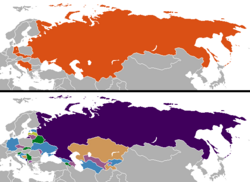

The dissolution of the Soviet Union has led to the creation of independent post-Soviet states, with the Russian SFSR declaring its independence in December 1991 and changing its name to the Russian Federation.
The Chechen Republic of Ichkeria was a secessionist government of the Chechen Republic during 1991–2000. After Russian defeat at the Battle of Grozny, the First Chechen War ended with Russia recognizing the new Ichkerian government of president Maskhadov in January 1997 and signing a peace treaty in May. But Russia invaded again in 1999, restoring a Chechen Republic and the Ichkeria government was exiled in 2000.
The Russian Federation has been involved in territorial disputes with several its neighbours, including with
The Russian Federation has also used its armed forces, armed formations, and material support to help establish the
In 2014, when after
On February 21, 2022, the Russian president Putin signed a decree recognizing the independence of two Donbas republics in Ukraine, and invaded the region. Two days later,
On 30 September 2022, Putin announced
See also
- Chechen–Russian conflict
- Foreign policy of the Russian Empire
- Foundations of Geopolitics
- History of the administrative division of Russia
- Internal colonialism
- Kaliningrad question
- Karelian question
- Moscow, third Rome
- Post-Soviet conflicts
- Russian imperialism
- Russian irredentism
- Near abroad
- Russian-occupied territories
- Russification
- Derussification
- Soviet Empire
- Timeline of geopolitical changes
- List of national border changes from 1815 to 1914
- List of national border changes (1914–present)
References
- ^ Allen F. Chew, An Atlas of Russian History: Eleven Centuries of Changing Borders (2nd ed. 1967). pp 14–43.
- ^ John Channon, The Penguin historical atlas of Russia (1995) pp 8–12, 44–75.
- ^ Brian Catchpole, A map history of Russia (1983) pp 6–31.
- ^ Allen F. Chew, An Atlas of Russian History: Eleven Centuries of Changing Borders (2nd ed. 1967)
- ^ "Empire of the steppe: Russia's colonial experience on the Eurasian frontier". www.international.ucla.edu. Retrieved 9 August 2021.
- ^ "The Great Game, 1856-1907: Russo-British Relations in Central and East Asia | Reviews in History". reviews.history.ac.uk. Retrieved 9 August 2021.
- ^ ISSN 1468-2281.
- ^ "Chernihiv gubernia". Encyclopedia of Ukraine. Retrieved 28 May 2020.
- ISBN 9781442651265.
- .
- )
- S2CID 162586404.
- ^ Vladimir Tismaneanu, Marius Stan, Cambridge University Press, 17 May, 2018, Romania Confronts Its Communist Past: Democracy, Memory, and Moral Justice, p. 132
- ISSN 0362-4331. Retrieved 30 November 2020.
- ^ "Interview given by Dmitry Medvedev to Television Channels Channel One, Rossia, NTV". President of Russia. Archived from the original on 17 December 2020. Retrieved 30 November 2020.
- ^ "Russia pledges to scale down military activity near Kyiv, Chernihiv — live updates". DW.COM. 29 March 2022. Retrieved 29 March 2022.
- ^ Ma, Alexandra. "Russia says its goal in Ukraine is to conquer the country's eastern and southern regions". Business Insider. Retrieved 24 April 2022.
- ^ "Ukraine war: What are Russia's plans for its 'second phase' - and why does it include Moldova?". ca.news.yahoo.com. 22 April 2022. Retrieved 24 April 2022.
- ^ "Signing of treaties on accession of Donetsk and Lugansk people's republics and Zaporozhye and Kherson regions to Russia". Kremlin.
- ^ "Putin says Russia has 'four new regions' as he announces annexation of Ukrainian territory". Reuters. 30 September 2022. Archived from the original on 30 September 2022. Retrieved 30 September 2022.
- ^ "Global condemnation for Russia's illegal annexation of Ukrainian territory". DW.
- ^ "Russia no longer has full control of any of four 'annexed' Ukrainian provinces". Guardian.
Further reading
- Bassin, Mark. "Russia between Europe and Asia: the ideological construction of geographical space." Slavic review 50.1 (1991): 1–17. Online
- Bassin, Mark. "Expansion and colonialism on the eastern frontier: views of Siberia and the Far East in pre-Petrine Russia." Journal of Historical Geography 14.1 (1988): 3–21.
- Forsyth, James. "A History of the Peoples of Siberia: Russia's North Asian Colony 1581–1990" (1994)
- Foust, Clifford M. "Russian expansion to the east through the eighteenth century." Journal of Economic History 21.4 (1961): 469–482. Online
- LeDonne, John P. The Russian empire and the world, 1700–1917: The geopolitics of expansion and containment (Oxford University Press, 1997).
- McNeill, William H. Europe's Steppe Frontier: 1500–1800 (Chicago, 1975).
- ISBN 978-0-8020-5808-9.
- Plamen Mitev, ed. Empires and peninsulas: Southeastern Europe between Karlowitz and the Peace of Adrianople, 1699-1829 (LIT Verlag Münster, 2010).
- Treadgold, Donald W. "Russian expansion in the light of Turner's study of the American frontier." Agricultural History 26.4 (1952): 147–152. Online
- Velychenko, Stephen, The Issue of Russian Colonialism in Ukrainian Thought.Dependency Identity and Development, AB IMPERIO 1 (2002) 323-66
Atlases
- Blinnikov, Mikhail S. A geography of Russia and its neighbors (Guilford Press, 2011) Borrow at Internet Archive
- Catchpole, Brian. A map history of Russia (1983)
- Chew, Allen F. An Atlas of Russian History: Eleven Centuries of Changing Borders (2nd ed. 1967) Borrow at Internet Archive
- Gilbert, Martin. Routledge Atlas of Russian History (4th ed. 2007) 8th ed. 2010 at Internet Archive
- Parker, William Henry. An historical geography of Russia (University of London Press, 1968) Borrow at Internet Archive
- Shaw, Denis J.B. Russia in the modern world: A new geography (Blackwell, 1998) Borrow at Internet Archive









